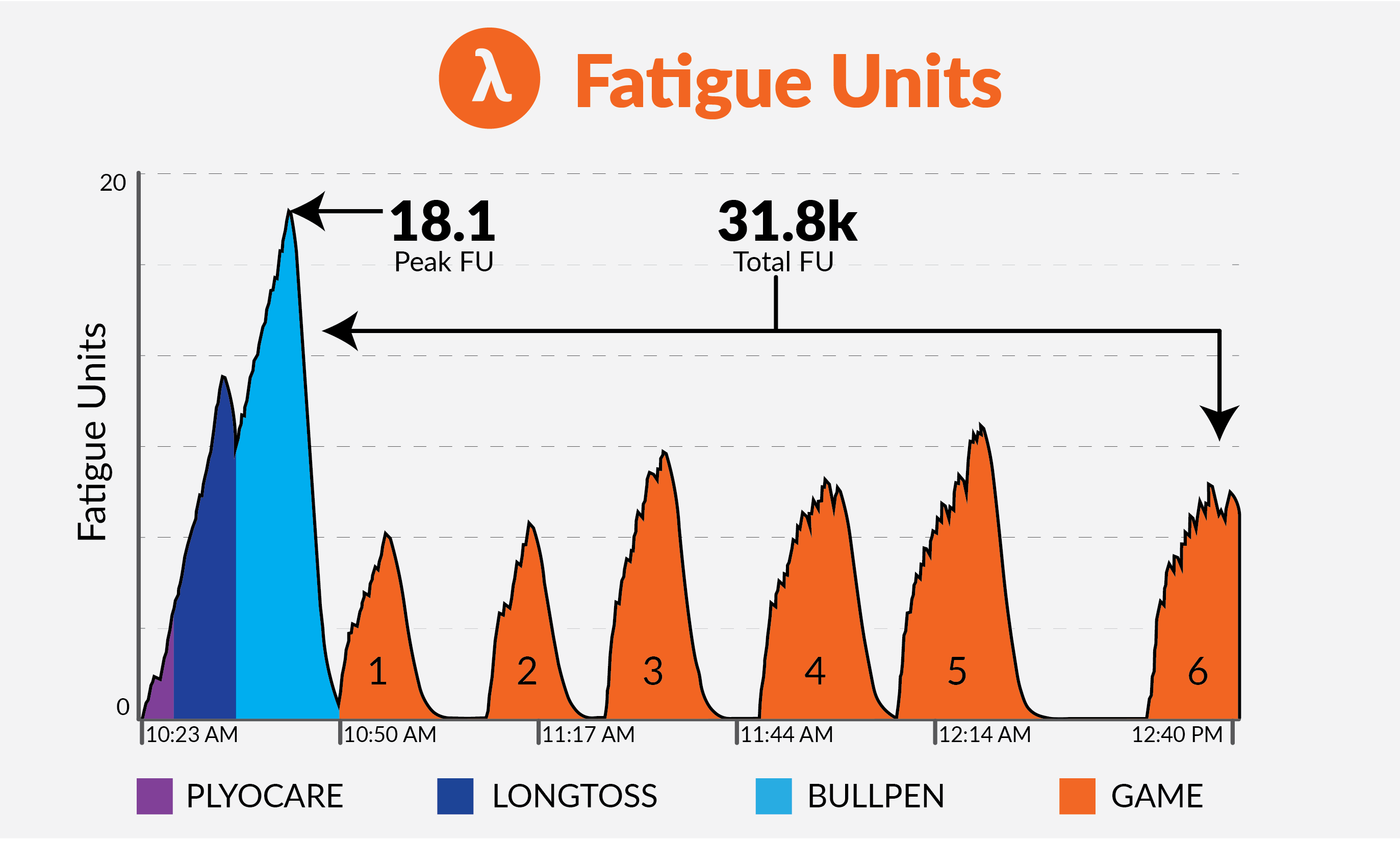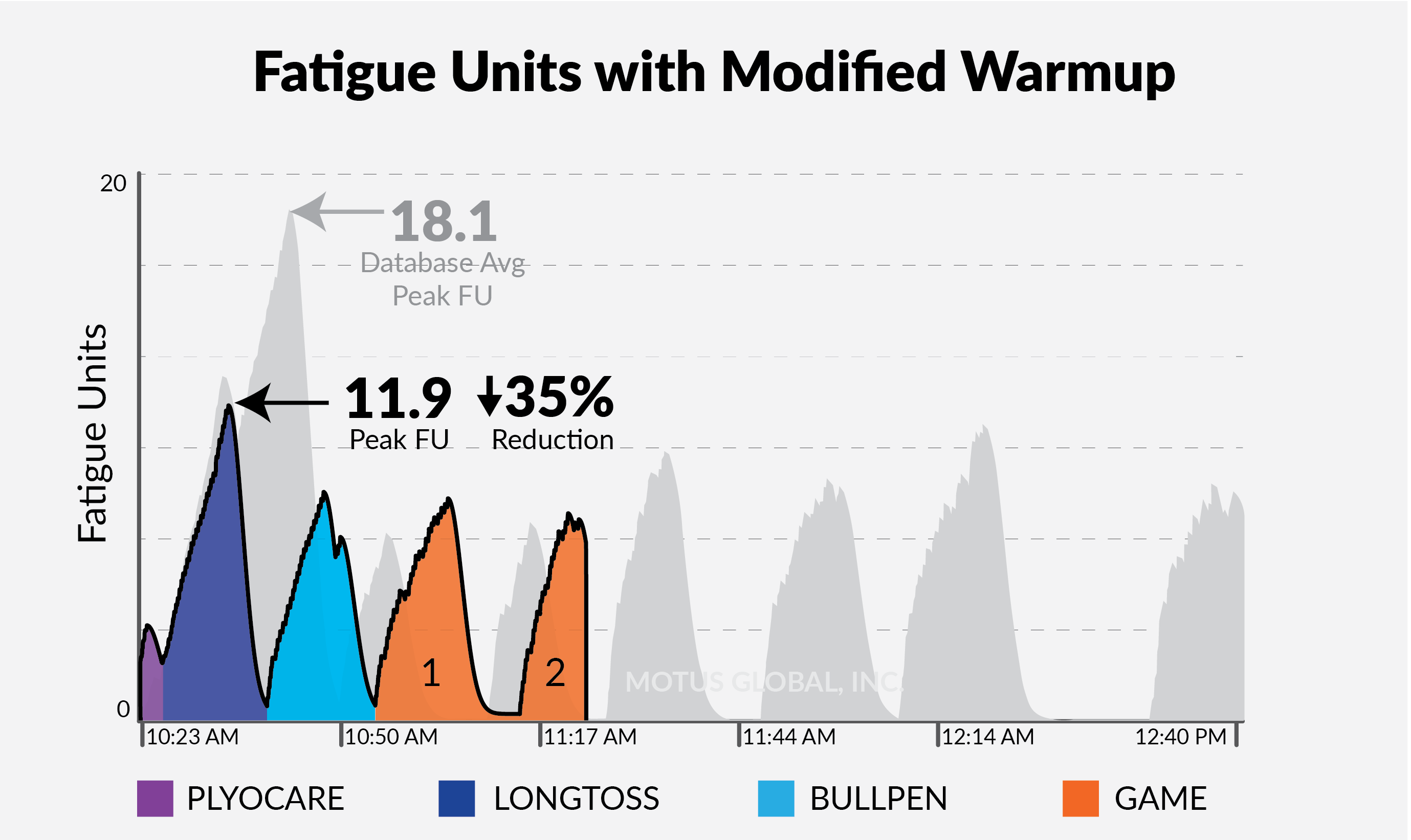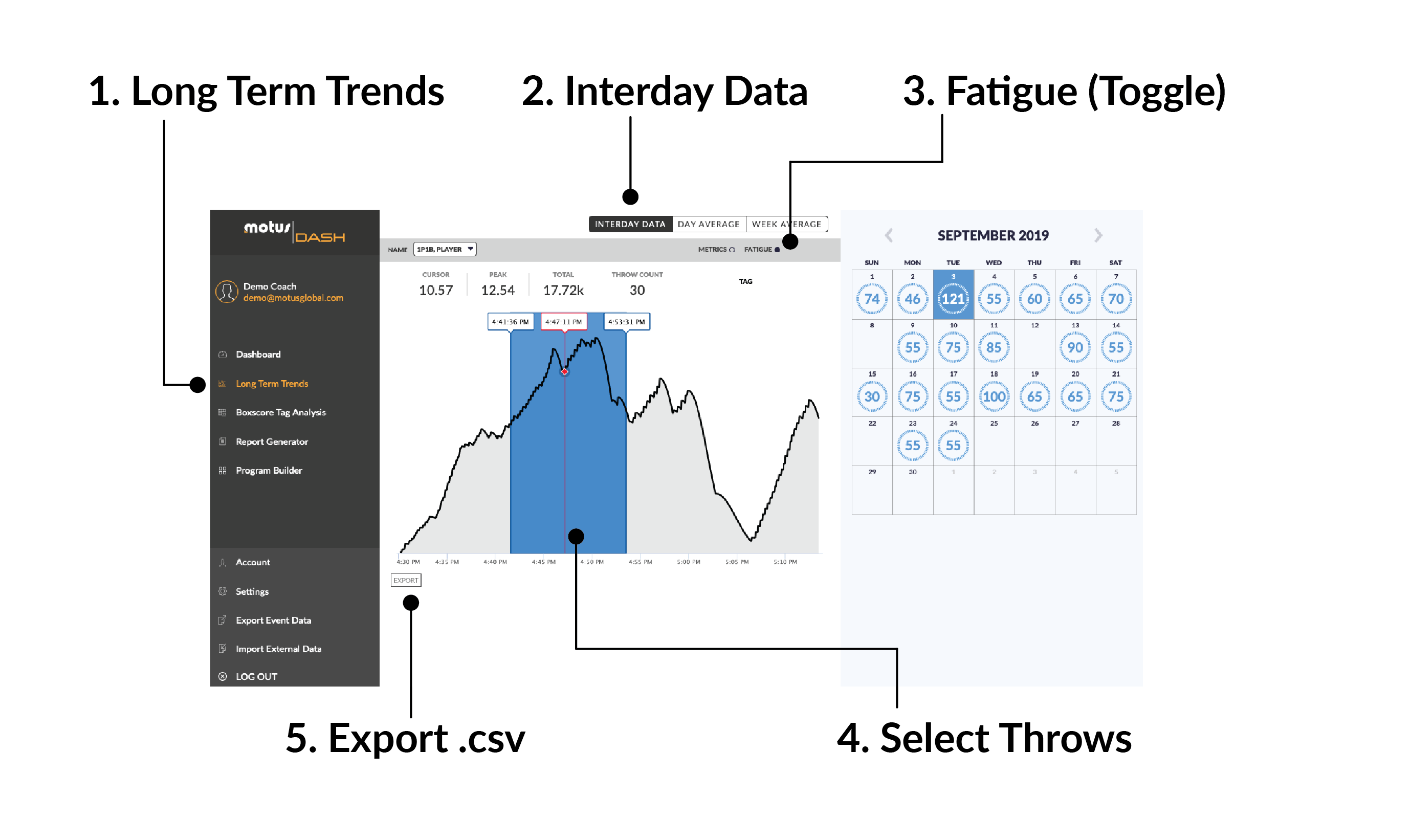Motus Advances Workload Models with Fatigue Units

What if pre-game warmups were the cause of the Tommy John epidemic? And not just because of the un-tracked volume of pre-game work (which is much too large), but what if it was because of the rate at which warmup throws occur? The average time between pitches in a baseball game is 15 seconds, but the average time between throws during longtoss and bullpen warmups is about 3.5 seconds. Muscles need time to recover from fatigue, so surely this time gap must factor into a pitcher’s physiological workload.
To capture this phenomenom, motusDASH web-app users now have access to Fatigue Units computed over each second of every throwing day. While Motus’ modified 9-day ACR and Chronic workload measures help identify fatigue over the scale of weeks and months, Fatigue Units are targeted to identify fatigue on the scale of seconds and minutes within a single day. Powered by peak torque of each throw, Fatigue Units accumulate during periods of high throwing frequency and regenerate during periods of rest.
Fatigue Units were first developed in 2014 by Dr. Michael Sonne (pronounced “Sawn”) based on publicly available pitchFX data. The models created by Sonne investigated the reduction in various arm muscles’ ability to generate force when exposed to repetitive activity. His early work was inspired by the implementation of the “pitch clock” (link), and showed how making pitchers throw sooner with less time between pitches was exposing pitchers to increased muscle fatigue and ultimately injury risk.
When it comes to injuries in pitchers, fatigue is the leading risk factor. First quantified via ASMI’s 10-year youth baseball study, researchers found that self-reported “throwing while fatigued” resulted in a 36x increase in injury risk [1].The researchers also quantified seasonal fatigue effects, finding that throwing over 100 innings in an calendar year resulting in a 3.5x increase in injury risk. On the scale of weeks and months, research from Dr. Sameer Mehta found that throwing while the acute:chronic ratio is greater than 1.3 resulted in a 15.2x increase in injury risk [2]. Fatigue can manifest in even shorter time-frames.
Motus and Sonne collaborated together with some of the brightest minds in baseball to bring Fatigue Units into further action, including Dr. Tim Gabbett, Dr. Chris Camp, Bryan Conger, and Zach Dechant. The full white-paper behind the science of Motus’ modified Fatigue Units can be found here (link) and recent coverage of the application of fatigue and workload management can be found at IEEE Spectrum, here (link).”Our fatigue model was originally developed to evaluate the effects of forces, cycle times, and postures on muscle fatigue accumulation during repetitive occupational tasks. If a worker is asked to perform the same number of tasks, at the same intensity, but you take away their rest time – their fatigue levels go up. I adapted this fatigue model when I first heard about the concept of the MLB including pitch clocks to reduce the time between pitches”, said Sonne.
“There’s some mathematical modelling that we’ve performed to get these numbers, but at the end of the day it’s really just common sense – recovery time is key to understanding fatigue. Fatigue Units were created to be a better representation of what is happening physiologically in pitchers compared to traditional metrics like pitch counts or innings pitched, and our initial research shows it is a much better indicator of high workloads. Combining this research with the MOTUS technology is the absolute best way to take these findings to coaches and players across the world, and develop better strategies to improve performance while limiting risk of injury”, he added.
Below in Figure 1 is an example of Fatigue Units (FU’s) computed for a starting pitcher who completed six innings of work while wearing the motusTHROW. Each throw increases the current level of FU’s based on the valgus torque of the throw. If a pitcher rests 3 minutes between throws, the FU’s decay back to zero; however, if a pitcher makes consecutive throws in a short time interval (3-20 seconds apart), the FU’s build on each other and the fatigue decay rate starts over. The longer the gap of time between throws, the more the FU’s decay. Motus provides both the total accumulated FU’s on the day and the peak FU’s on the day.

In this example, the pitcher has 7 local peaks of FU’s: his warmup routine (longtoss and bullpen) and 6 distinct innings. Notice how during the warmup the rapid rate of throwing and large volume of throwing results in a peak FU that is almost twice that of any inning’s peak. Furthermore, the lack of rest and rapid transition from longtoss to bullpen throwing compounds the buildup of FU’s well into the fast-paced pregame bullpen session. This is a common trend in the nearly 20,000 game datasets that Motus has recorded since the launch of the sleeve in 2015. Pitchers tend to follow this traditional strategy of warmups, which result in large FU peaks prior to competitive throwing.
However, this exposure of peak FU’s in pregame warmups is modifiable and avoidable. A professional pitcher competing in the Arizona Fall League and active Motus/WASP client (who asked for anonymity), self-modified his approach to warmups and lowered his peak pregame FU’s by almost 35%. “I tried to take a breath and count to five between each warmup throw and it really slowed me down. I took my time and I wasn’t exhausted at all. It felt really efficient”, he said.
This pitcher’s approach is a sign of a newer-age of pitchers coming that have taken data into their own hands. Outside of workload management via Motus’ WASP to build chronic workload and minimize acute:chronic ratios via personalized projections, his ability to lower Fatigue Units on game-days created more capacity for competitive in-game throwing in the Arizona Fall League.

To access Fatigue Units on Motus data, users must be subscribed to the advanced analytics platform, motusDASH (https://motusthrow.motusdash.com). On each day of throwing, Fatigue Units can be viewed under the Trends/Interday Data module, after toggling the “Fatigue” selector. The interactive Fatigue Unit module allows users to select batches of time to view throwing volume densities and totals, inspect local FU’s over time, view peak and accumulated FU’s on each day, and allows users to export .csv’s of FU’s over each second in the day for their own research.
The tools available with the launch of Fatigue Units is yet another step forward in transforming Motus’ wearable technology data into physiologically relevant measures. As Motus continues to research and mine Fatigue Unit data as it relates to injury and performance, additional features will be developed to give even more actionable insights to users.
While MLB in-game rules allow in-game wear, those same rules prevent users from downloading data during the game. In the near future and with rule-changes, Motus envisions the ability to have Fatigue Units available in-game to allow players and staff to better time mound visits and ultimately have better insights into when daily limits are reached.

Contact our support team to start instituting a workload management program
(425) 523-4030
[email protected]
Easier to use
New, more accurate metrics
Lower Price!
References:
- Olsen SJ, Fleisig GS, Dun S, Loftice J, Andrews JR. Risk factors for shoulder and elbow injuries in adolescent baseball pitchers. Am J Sports Med. 2006;34:905-912 [PubMed]
- Mehta S. Relationship between workload and throwing injury in varsity baseball players. Phys. Therapy in Sport. 2019;40:66-70 [ScienceDirect]
Comment section